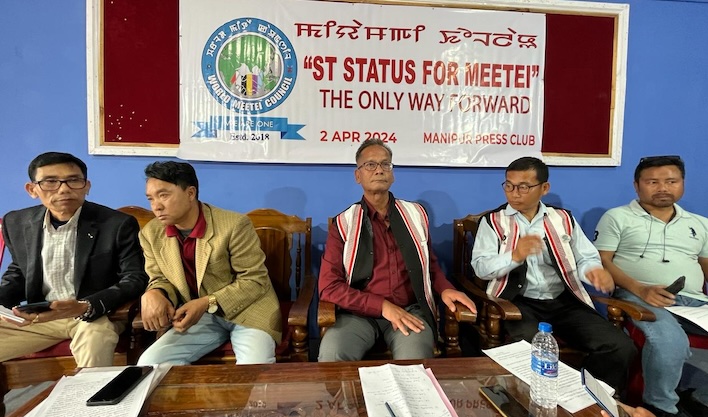Source: World Meeitei Council
After the integration of Manipur into India in October 1949, various laws framed by the Government of India have reserved the Hill Areas of Manipur (92%) exclusively for Scheduled Tribes (ST). Meetei, being not ST, has been restricted to live only in the tiny Central Valley areas (8%) with people from all communities of different castes, creeds and religions including those belonging to Scheduled Tribes.
All land laws currently in force in Manipur including MLR & LR Act 1960, Article 371(C) of the Constitution of India, were framed during the period 1950-1972, prejudicially to subdue forever the growth of Meetei under hectic lobby and masterstroke of a crafty Kuki IAS officer who had a mind-boggling strategic vision of establishing a ‘Kukiland’ by dismembering Manipur. The design of the Kukis may be defeated by including Meetei in the ST list.
Since the first notification of the ST list of Manipur on 20th September 1951, all ST communities of Manipur including the migrant Kukis have developed fast in all spheres as they have been enjoying all the benefits, rights and privileges meant for STs under the Constitution of India. On the other hand, the socio-economic conditions of Meetei have been deteriorating steadily day by day as they have missed avail of those benefits, rights and privileges extended to STs.
An anomalous situation happening in Manipur is that while the Kukis who are refugees/migrants have been granted Scheduled Tribe status right from the Notification of the first Scheduled Tribes list of Manipur, 1951 with the privileges guaranteed under the Constitution of India, the indigenous Meeteis have been denied to enjoy the Scheduled Tribe status till date although Meeteis fulfil the set criteria for inclusion in the ST list under Article 342(1) of the Constitution of India right from the time of the merger of Manipur into India in 1949.
Meetei’s holding of land in the Central Valley is continuously shrinking fast due to selling of their land to people of other communities and it stands today at just about 3% of Manipur’s total area. The situation is likely to aggravate faster with the arrival of railways and Trans-Asian Highways.
The annual population growth rate of Meetei during the period 1881-2011 was 7.17 which is the least as compared to those of other communities. In particular, the annual population growth rate of Muslims during the same period was 37.03. Since the growth rate of Muslims is more than 5 times that of Meetei, it is obvious that Muslims will overtake Meetei in population in the next few decades. The census data of Manipur for the years 1881 and 2011 reveals an imbalanced picture of demography as shown below:

According to the Report of the 5th National Family Health Survey (2019-2020) conducted by the Ministry of Health and Family Welfare, Government of India, the Total Fertility Rate (TFR) for the Meetei community in Manipur is 1.77. The critical minimum value of TFR required by a community for the sustenance of its survival is 2.11. The TFR value (1.77) for the Meetei community is much lower than the critical TFR value of 2.11 and it signifies that the population of Meetei is decreasing fast. The low value of TFR is related to the poor economic condition of the Meetei community in Manipur. Thus, it is true that the Meetei community is looming large on extinction in the not much distant future unless drastic corrective measures such as protection under the’ tag are taken up as soon as possible.
Combining all factors viz., shrinking of land area, declining rate of population growth and low value of TFR, it is readily projected that Meetei will become a minority community in Manipur in the coming decades, that too with no sufficient land to accommodate their populace and subsequently, waiting for extinction in their homeland Manipur.
Since the British Government of India recognized Meetei as a primitive hill tribe right from the Census of India 1881, as may be verified from many sources of authority such as census reports published by the British government of India, various books and research articles authored by contemporary British ethnographers, linguists and administrators, the ethnic Meetei community qualifies all the criteria for inclusion as a Scheduled Tribe under Article 342(1) of the Constitution of India.
The statements, views and opinions expressed in this column are solely those of the author and do not necessarily represent those of the NEA.


